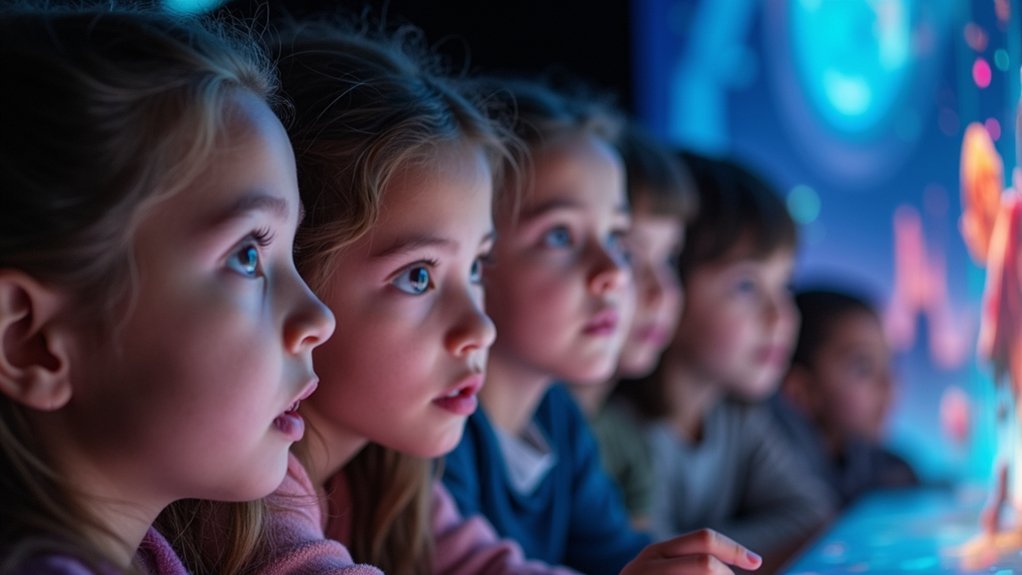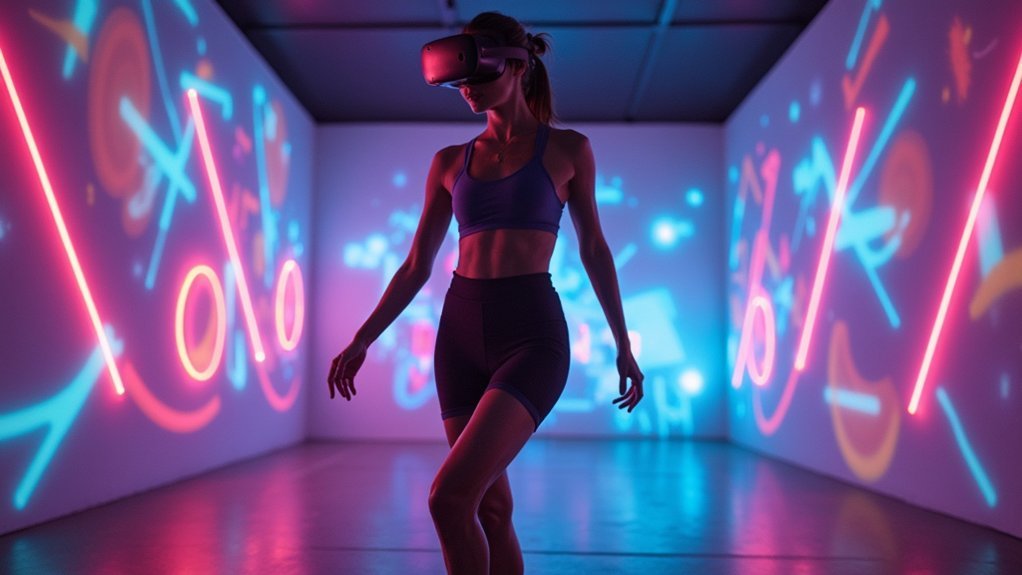You can transform your immersive storytelling by positioning focal points within viewers’ natural sight lines and using 3D objects instead of flat elements for realistic engagement. Synchronize directional audio with visual elements to guide attention to key narrative moments while maintaining high-contrast visuals and dynamic animations within the central 30-degree visual field. Monitor fixation duration and gaze patterns to optimize your narrative pacing, then transform this data into interactive hotspots that enhance viewer engagement and maintain focus throughout your story.
Design VR Environments That Guide Natural Eye Movement

When designing VR environments for effective storytelling, you’ll want to strategically position focal points and interactive elements within users’ natural sight lines to guide their attention seamlessly. This approach enhances immersive storytelling by creating believable visual pathways that encourage exploration.
Use 3D objects instead of flat elements—users naturally engage more with realistic components that mirror real-world behaviors. Implement natural physics to make interactions feel authentic, prompting users to investigate areas that catch their eye. This improves eye tracking in VR data collection considerably.
Incorporate corresponding background sounds that draw visual attention to specific environmental areas. Simplify scenes while maintaining credibility to trick the brain into fuller engagement, promoting organic gaze patterns.
These techniques optimize natural eye movement and generate higher-quality user experience data for your storytelling objectives.
Leverage Audio Cues to Direct Viewer Attention
Beyond the visual elements that shape your VR environment, strategic audio placement becomes your most powerful tool for directing viewer attention exactly where you want it.
Audio cues naturally influence gaze direction by drawing your viewers’ eyes toward specific locations within your immersive storytelling experience.
Strategic audio placement acts as an invisible hand, naturally guiding your audience’s gaze to precisely where your story needs their attention most.
Effective audio implementation for eye tracking optimization includes:
- Synchronize sounds with visual elements to enhance memory retention and strengthen narrative impact
- Use directional audio to create spatial awareness and guide focus toward key story moments
- Eliminate incongruous audio cues that distract from your intended narrative flow
- Incorporate naturalistic background sounds that align with your scene’s context for deeper immersion
Optimize Visual Elements for Eye Tracking Accuracy
Since your visual design choices directly impact eye tracking precision, you’ll need to prioritize high-contrast elements that naturally capture and hold viewer attention. Dynamic animations greatly increase gaze fixation compared to static images, making movement essential for accurate eye tracking data collection.
Position vital storytelling elements within the central 30-degree visual field where eye gaze measurements are most reliable. Apply Gestalt principles to create natural focal points that guide customer attention seamlessly through your narrative.
| Visual Element | Eye Tracking Impact |
|---|---|
| High contrast colors | Increased attention capture |
| Dynamic animations | Enhanced gaze fixation |
| Central positioning | Improved data accuracy |
| Gestalt focal points | Natural attention flow |
| Clutter-free layouts | Reduced attention scatter |
Keep your immersive storytelling environment uncluttered—excessive visual elements scatter focus and compromise your ability to optimize visual elements effectively.
Use Eye Tracking Data to Refine Narrative Pacing
Effective storytelling pacing emerges when you analyze eye tracking data to pinpoint exactly where your audience’s attention wavers or intensifies. Eye tracking reveals critical moments where viewers disengage, enabling you to adjust narrative pacing strategically.
You’ll maintain viewer engagement by identifying fixation patterns and saccade movements that signal interest levels.
Transform your storytelling effectiveness through these data-driven approaches:
- Monitor fixation duration to determine which scenes captivate audiences and warrant extended exploration
- Track gaze patterns to optimize timing of plot reveals and emotional beats
- Identify attention shifts that signal when to accelerate or decelerate narrative flow
- Analyze multi-viewing trends to refine structural elements iteratively
Create Interactive Hotspots Based on Gaze Patterns

When you transform gaze pattern data into interactive hotspots, you’re creating responsive narrative experiences that adapt to each viewer’s natural attention tendencies. Eye tracking reveals where users focus most frequently and for how long, enabling you to position hotspots strategically for maximum user engagement.
| Gaze Pattern | Hotspot Type | Implementation Strategy |
|---|---|---|
| High frequency focus | Primary interaction | Place key narrative elements |
| Extended duration | Secondary content | Add supplementary information |
| Brief glances | Ambient details | Integrate subtle enhancements |
| Distracted zones | Redirect mechanism | Guide attention back to story |
VR research demonstrates that gaze-based hotspots considerably increase immersion by aligning with natural visual behavior. You’ll identify confusion areas and redesign accordingly, ensuring smoother immersive storytelling experiences that respond dynamically to individual interaction patterns.
Frequently Asked Questions
How to Make Eye Tracking Better?
You’ll improve eye tracking by calibrating devices properly, using infrared technology for better accuracy, incorporating natural interactions, experimenting with visual stimuli, and combining gaze data with other sensory inputs for thorough analysis.
What Are Two Key Measures for Eye Tracking?
You’ll focus on two key measures: fixation duration, which shows how long you’re looking at specific points, and saccades, which track your rapid eye movements between those fixation points.
How to Improve Eye Tracking for Reading?
You’ll improve eye tracking accuracy by calibrating devices before sessions, ensuring ideal lighting conditions, and implementing user-friendly interfaces that minimize cognitive load while incorporating real-time feedback mechanisms for better reading experiences.
What Is the Eye Tracking Technique?
You’ll use specialized devices with infrared technology to measure where your gaze focuses. This technique captures your eye movements and fixations in real-time, providing valuable data about your attention patterns and visual engagement.
In Summary
You’ve got the tools to transform your VR storytelling through strategic eye tracking implementation. By designing intuitive environments, using audio cues effectively, optimizing visual elements, analyzing pacing data, and creating gaze-responsive hotspots, you’ll craft truly immersive experiences. Don’t just tell your story—guide your viewers through it naturally. Start implementing these techniques today, and you’ll notice how eye tracking data becomes your secret weapon for creating compelling, user-centered narratives that captivate audiences.





Leave a Reply